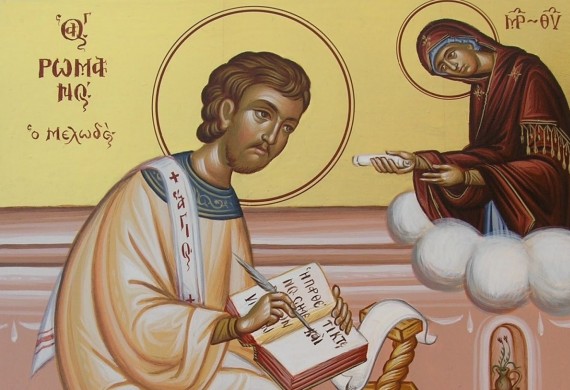Troparion — Tone 4
You gladdened Christ’s Church by your melodies / like an inspired heavenly trumpet. / You were enlightened by the Mother of God / and shone on the world as God’s poet. / We lovingly honor you, righteous Romanos.
We have scarce information about the life of Saint Romanos. He was born in Emesis and was ordained a deacon in the Church of Beirut. Then he moved to Constantinople under Emperor Anastasios I and Patriarch Euphymios (490-496).
Romanos was pious and virtuous since his childhood. He fervently honored the Mother of God and attended the Church services regularly.
He had an urge to glorify the Theotokos, but was hindered by insufficient musical and vocal talent. Then, one time, during the Nativity Vigil in the Church of Blachernes in Constantinople, the Mother of God appeared to him and gave him a scroll, which she commanded him to eat.
It had a sweet taste that filled his mouth. Then Romanos mounted the pulpit in the church and began to chant with an angelic voice the hymn which is known as the kontakion to the Mother of God: “Today the Virgin gives birth to Him who is above all being,
And the earth offers a cave to Him whom no man can approach.
Angels with shepherds give glory,
And magi journey with a star.
For unto us is born a young child,
The pre-eternal God.”
From then on, the gift of the Holy Spirit poured inside him abundantly and did not leave him. He composed an immense amount of hymns which covered most of the liturgical year. Romanos is the inventor of the “kondakion”, in reference to the Virgin’s scroll that he was given to eat. It is mainly a group of 20-24 strophes called “oikoi” (from the Greek “oikos”- “house”), which contain a number of troparia.
Saint Romanos is said to have produced a thousand of these kondakia, of which only eighty remain today. Among these kondakia attributed to him is the Akathist to the Mother of God that the Church sings during Great Lent.
It is noteworthy that Saint Romanos was the first to put the letter (T) in Greek before his name. This letter refers to the word (Tapinos), which means humble. This same sign was later adopted by the bishops, in the form of a small cross.
The saint’s liturgical service for vespers beautifully praises him as follows: “Thou didst show thyself to be a first-offering of good works, a starting-point of salvation, O Romanos our father; for, composing angelic hymns, thou didst show thy life to be godly. Entreat Christ God, that He deliver from perils and tribulations those who hymn thee.”
Saint Romanos reposed in the Lord as a deacon of the great church in Constantinople
Source:
https://www.antiochpatriarchate.org/en/page/saint-romanos-the-melodist/777/

